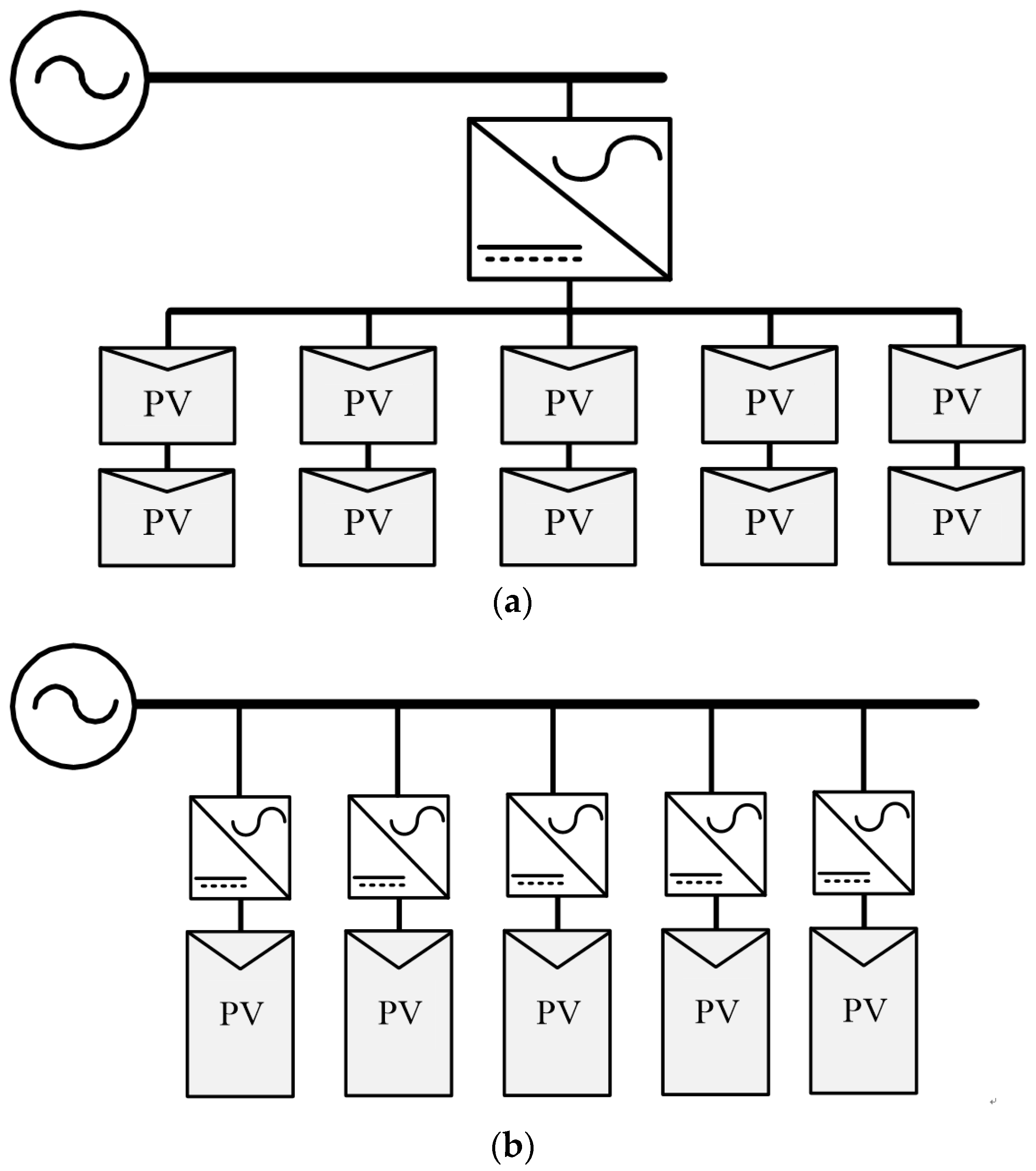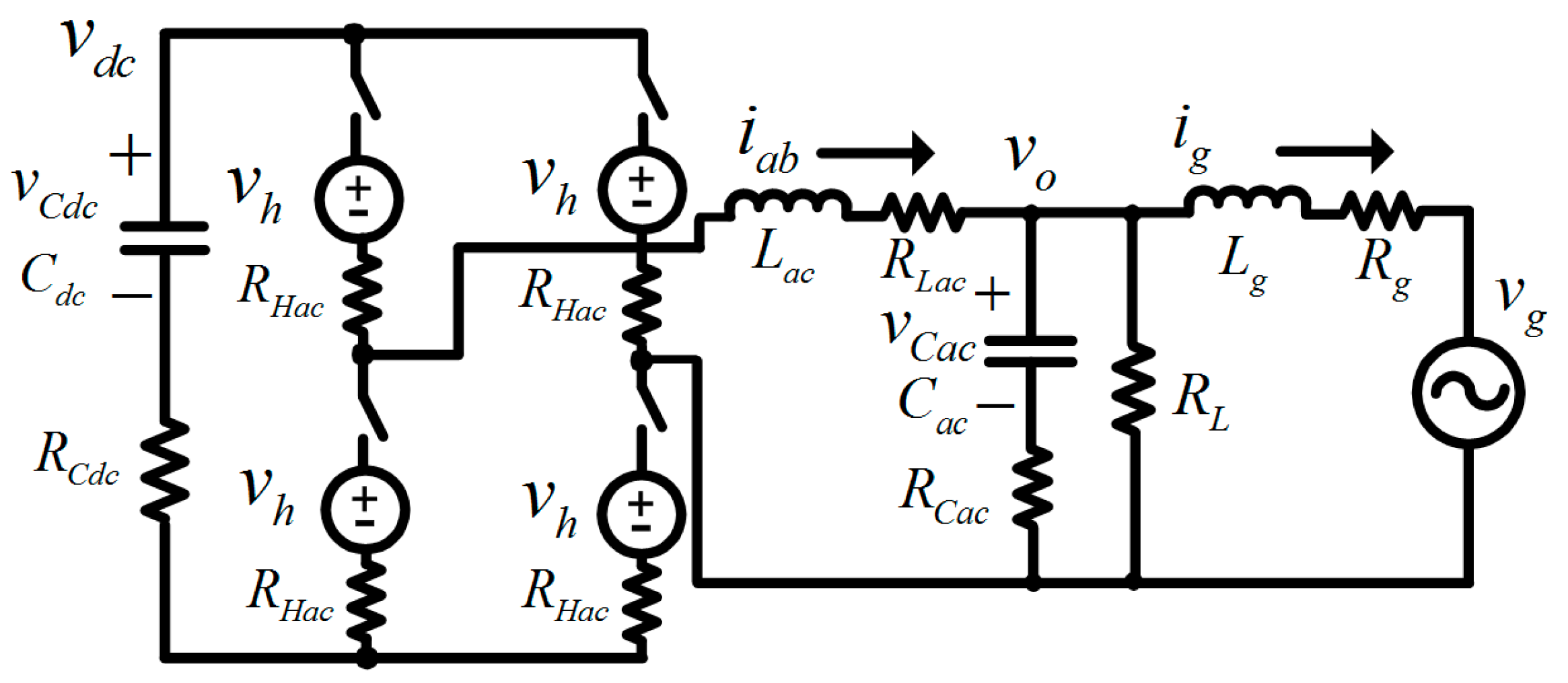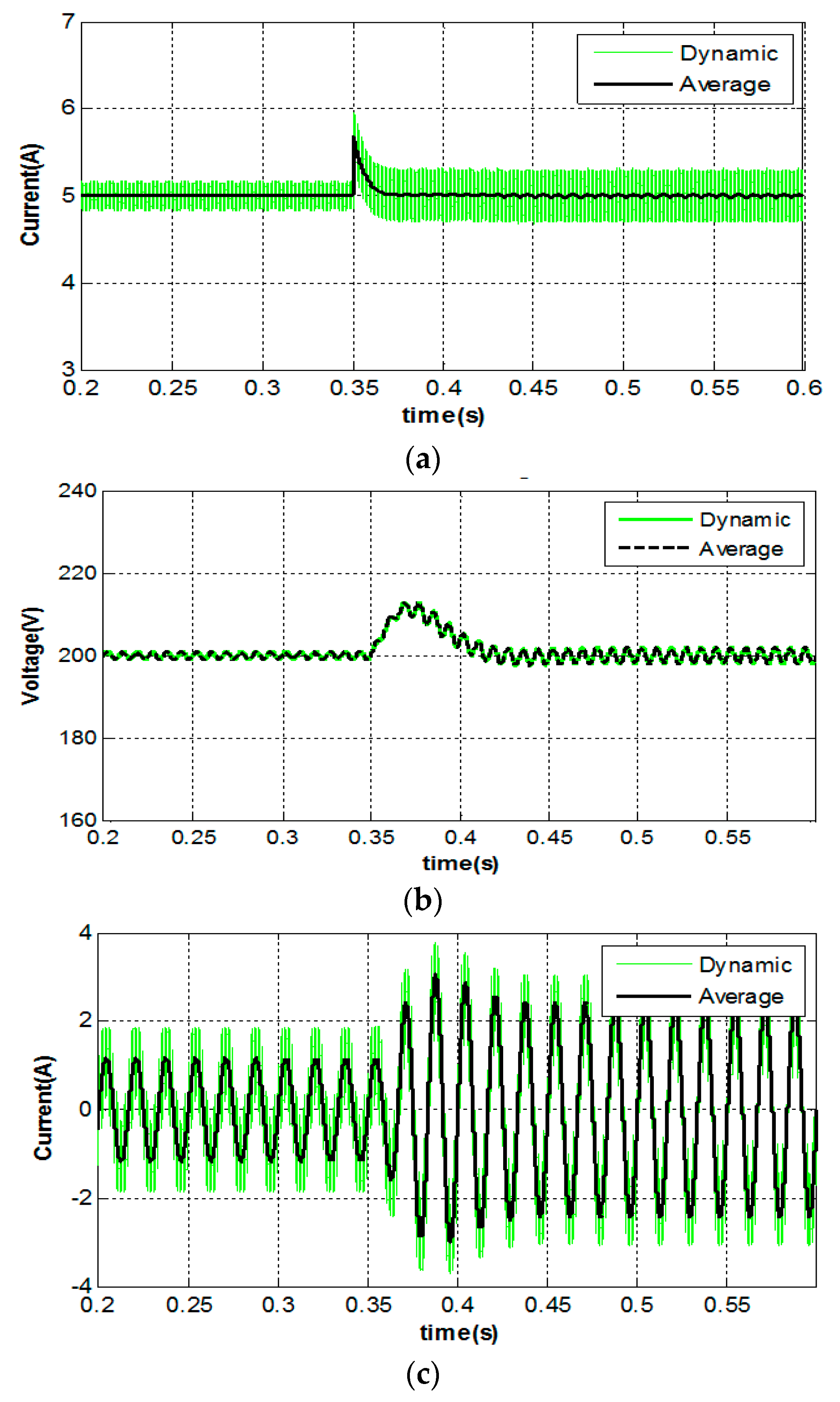A Time-Efficient Approach for Modelling and Simulation of Aggregated Multiple Photovoltaic Microinverters
Abstract
:1. Introduction
2. Proposed Simulation Strategy and State-Space Average Model with a Single Matrix-Form
2.1. DC-DC Converter Model
2.2. DC-AC Converter Model
2.3. Combined Average Model
3. Model Validation
4. Control Strategy for PV Microinverter
5. Aggregated Microinverter in PV Applications
6. Conclusions
Acknowledgments
Author Contributions
Conflicts of Interest
Abbreviations
| PV | photovoltaic |
| PCS | power conditioning system |
| MIC | module-integrated converter |
| MPPT | maximum power point tracking |
| PWM | pulse width modulation |
| CCM | continuous conduction mode |
| DCM | discontinuous conduction mode |
| SMF | single-matrix-form |
Appendix A
References
- Scholten, D.M.; Ertugrul, N.; Soong, W.L. Micro-inverters in small scale PV systems: A review and future directions. In Proceedings of the Australasian Universities Power Engineering Conference (AUPEC), Hobart, Australia, 29 September–3 October 2013. [Google Scholar]
- Adinolfi, G.; Graditi, G.; Siano, P.; Piccolo, A. Multi-Objective Optimal Design of Photovoltaic Synchronous Boost Converters Assessing Efficiency, Reliability and Cost Savings. IEEE Trans. Ind. Inform. 2015, 11, 1038–1048. [Google Scholar] [CrossRef]
- Liu, C.; Sun, P.; Lai, J.S.; Ji, Y.; Wang, M.; Chen, C.L.; Cai, G. Cascade dual-boost/buck active-front-end converter for intelligent universal transformer. IEEE Trans. Ind. Electron. 2012, 59, 4671–4680. [Google Scholar]
- Libo, W.; Zhengming, Z.; Jianzheng, L. A Single-Stage Three-Phase Grid-Connected Photovoltaic System with Modified MPPT Method and Reactive Power Compensation. IEEE Trans. Energy Convers. 2007, 22, 881–886. [Google Scholar] [CrossRef]
- Martins, D.C. Analysis of a three-phase grid-connected PV power system using a modified dual-stage inverter. ISRN Renew. Energy 2013, 2013, 406312. [Google Scholar] [CrossRef]
- Koran, A.; LaBella, T.; Lai, J. High efficiency photovoltaic source simulator with fast response time for solar power conditioning systems evaluation. IEEE Trans. Power Electron. 2014, 29, 1285–1297. [Google Scholar] [CrossRef]
- Seyedmahmoudian, M.; Mekhilef, S.; Rahmani, R.; Yusof, R.; Renani, E.T. Analytical modeling of partially shaded photovoltaic systems. Energies 2013, 6, 128–144. [Google Scholar] [CrossRef]
- Seyedmahmoudian, M.; Horan, B.; Rahmani, R.; Maung Than Oo, A.; Stojcevski, A. Efficient photovoltaic system maximum power point tracking using a new technique. Energies 2016, 9, 147. [Google Scholar] [CrossRef]
- Aurilio, G.; Balato, M.; Graditi, G.; Landi, C.; Luiso, M.; Vitelli, M. Fast hybrid MPPT technique for photovoltaic applications: Numerical and Experimental validation. Adv. Power Electron. 2014, 2014, 125918. [Google Scholar] [CrossRef]
- Graditi, G.; Adinolfi, G.; Femia, N.; Vitelli, M. Comparative analysis of synchronous rectification boost and diode rectification boost converter for DMPPT applications. In Proceedings of the 2011 IEEE International Symposium on Industrial Electronics (ISIE), Gdansk, Poland, 27–30 June 2011; pp. 1000–1005. [Google Scholar]
- Graditi, G.; Adinolfi, G.; Tina, G.M. Photovoltaic optimizer boost converters: Temperature influence and electro-thermal design. Appl. Energy 2014, 115, 140–150. [Google Scholar] [CrossRef]
- Liu, Y.; Hu, Z.; Zhang, Z.; Suo, J.; Liang, K. Research on the three-phase photovoltaic grid-connected control strategy. Energy Power Eng. 2013, 5, 31–35. [Google Scholar] [CrossRef]
- Bojoi, R.I.; Limongi, L.R.; Roiu, D.; Tenconi, A. Enhanced power quality control strategy for single-phase inverters in distributed generation systems. IEEE Trans. Power Electron. 2011, 26, 798–806. [Google Scholar] [CrossRef]
- Cecati, C.; Khalid, H.; Tinari, M.; Adinolfi, G.; Graditi, G. Hybrid DC Nano grid with renewable energy sources and modular DC/DC LLC converter building block. IET Power Electron. 2016, 10, 536–544. [Google Scholar] [CrossRef]
- Hu, H.; Harb, S.; Kutkut, N.; Batarseh, I.; Shen, Z.J. A review of power decoupling techniques for microinverters with three different decoupling capacitor locations in PV systems. IEEE Trans. Power Electron. 2013, 28, 2711–2726. [Google Scholar] [CrossRef]
- Kim, K.A.; Lertburapa, S.; Xu, C.; Krein, P.T. Efficiency and cost trade-offs for designing module integrated converter photovoltaic systems. In Proceedings of the IEEE Power and Energy Conference at Illinois, Champaign, IL, USA, 24–25 February 2012; pp. 1–7. [Google Scholar]
- Chen, B.; Gu, B.; Zhang, L.; Zahid, Z.U.; Lai, J.-S.; Liao, Z.; Ho, R. A high-efficiency MOSFET transformer less inverter for nonisolated microinverter applications. IEEE Trans. Power Electron. 2015, 30, 3610–3622. [Google Scholar] [CrossRef]
- Lin, F.J.; Chiang, H.C.; Chang, J.K. Modeling and controller design of PV micro inverter without using electrolytic capacitors and input current sensors. Energies 2016, 9, 993. [Google Scholar] [CrossRef]
- Spertino, F.; Graditi, G. Power conditioning units in grid-connected photovoltaic systems: A comparison with different technologies and wide range of power ratings. Sol. Energy 2014, 108, 219–229. [Google Scholar] [CrossRef]
- Middlebrook, R.D. Small-signal modeling of pulse-width modulated switched-mode power converters. Proc. IEEE 1988, 76, 343–354. [Google Scholar] [CrossRef]
- Li, W.; Bélanger, J. An equivalent circuit method for modelling and simulation of modular multilevel converters in real-time HIL test bench. IEEE Trans. Power Deliv. 2016, 31, 2401–2409. [Google Scholar] [CrossRef]
- Abramovitz, A. An approach to average modeling and simulation of switch-mode systems. IEEE Trans. Educ. 2011, 54, 509–517. [Google Scholar] [CrossRef]
- Dijk, E.; Spruijt, J.N.; O’Sullivan, D.M.; Klaassens, J.B. PWM-switch modeling of DC-DC converters. IEEE Trans. Power Electron. 1995, 10, 659–665. [Google Scholar] [CrossRef]
- Sun, J.; Mitchell, D.M.; Greuel, M.F.; Krein, P.T.; Bass, R.M. Averaged modeling of PWM converters operating in discontinuous conduction mode. IEEE Trans. Power Electron. 2001, 16, 482–492. [Google Scholar]
- Suntio, T. Unified average and small-signal modeling of direct-on-time control. IEEE Trans. Ind. Electron. 2006, 53, 287–295. [Google Scholar] [CrossRef]
- Davoudi, A.; Jatskevich, J.; Rybel, T. Numerical state-space average-value modeling of PWM DC-DC converters operating in DCM and CCM. IEEE Trans. Power Electron. 2006, 21, 1003–1012. [Google Scholar] [CrossRef]
- Davoudi, A.; Jatskevich, J. Parasitics realization in state-space average-value modeling of PWM DC-DC converters using an equal area method. IEEE Trans. Circuits Syst. I Reg. Pap. 2007, 54, 1960–1967. [Google Scholar] [CrossRef]
- Dupont, F.H.; Rech, C.; Gules, R.; Pinheiro, J.R. Reduced-order model and control approach for the boost converter with a voltage multiplier cell. IEEE Trans. Power Electron. 2013, 28, 3395–3404. [Google Scholar] [CrossRef]
- Emadi, A. Modeling and analysis of multiconverter DC power electronic systems using the generalized state-space averaging method. IEEE Trans. Ind. Electron. 2004, 51, 661–668. [Google Scholar] [CrossRef]
- Emadi, A. Modeling of power electronic loads in AC distribution systems using the generalized state-space averaging method. IEEE Trans. Ind. Electron. 2004, 51, 992–1000. [Google Scholar] [CrossRef]
- Bina, M.Y.; Bhat, A. Averaging technique for the modeling of STATCOM and active filters. IEEE Trans. Power Electron. 2008, 23, 723–734. [Google Scholar] [CrossRef]
- Figueres, E.; Garcera, G.; Sandia, J.; Gonzalez-Espin, F.; Rubio, J.C. Sensitivity study of the dynamics of three-phase photovoltaic inverters with an LCL grid filter. IEEE Trans. Ind. Electron. 2009, 56, 706–717. [Google Scholar] [CrossRef]
- Krein, P.T.; Bentsman, J.; Bass, R.; Lesieutre, B.C. On the use of averaging for the analysis of power electronic systems. IEEE Trans. Power Electron. 1990, 5, 182–190. [Google Scholar] [CrossRef]
- Meneses, D.; Blaabjerg, F.; García, O.; Cobos, J.A. Review and comparison of step-up transformerless topologies for photovoltaic AC-module application. IEEE Trans. Power Electron. 2013, 28, 2649–2663. [Google Scholar] [CrossRef]
- Rodriguez, C.; Amaratunga, G.A.J. Analytic solution to the photo-voltaic maximum power point problem. IEEE Trans. Circuits Syst. I Reg. Pap. 2007, 54, 2054–2060. [Google Scholar] [CrossRef]
- Park, S.M.; Bazzi, A.; Park, S.Y.; Chen, W. A time-efficient modeling and simulation strategy for aggregated multiple microinverters in large-scale PV systems. In Proceedings of the IEEE Applied Power Electronic Conference, Fort Worth, TX, USA, 16–20 March 2014. [Google Scholar]
- Subudhi, B.; Pradhan, R. A comparative study on maximum power point tracking techniques for photovoltaic power systems. IEEE Trans. Sustain. Energy 2013, 4, 89–98. [Google Scholar] [CrossRef]
- Mastromauro, R.A.; Liserre, M.; Dell’Aquila, A. Control issues in single-stage photovoltaic systems: MPPT, current and voltage control. IEEE Trans. Ind. Inform. 2012, 8, 241–254. [Google Scholar] [CrossRef]
- Blaabjerg, F.; Teodorescu, R.; Liserre, M.; Timbus, A.V. Overview of control and grid synchronization for distributed power generation systems. IEEE Trans. Ind. Electron. 2006, 53, 1398–1409. [Google Scholar] [CrossRef]
- Ma, L.; Sun, K.; Teodorescu, R.; Guerrero, J.M.; Jin, X. An integrated multifunction DC/DC converter for PV generation systems. In Proceedings of the IEEE International Symposium on Industrial Electronics, Bari, Italy, 4–7 July 2010. [Google Scholar]
- Mitsubishi Electric Corporation. Available online: http://www.mitsubishielectric.com/bu/solar/pv_modules/pdf/L-175-0-B8492-A.pdf ( accessed on 14 February 2017).


















| Parameters | Value | Parameters | Value |
|---|---|---|---|
| vpv | 25~40 V | Ldc | 2.63 mH |
| vg | 110 Vrms | RLdc | 0.15 Ω |
| Vd | 0.975 V | Lac | 1.3 mH |
| Vm | 0.2 V | RLac | 0.075 Ω |
| Vh | 0.2 V | Cdc | 680 μF |
| Rin | 0.2 Ω | RCdc | 0.03 Ω |
| RMdc | 0.029 Ω | Cac | 1 μF |
| Rd | 0.02 Ω | RCac | 0.01 Ω |
| RHac | 0.029 Ω | Lg | 3 mH |
| RL | 62.5 Ω | Rg | 0.01 Ω |
| Parameters | Simulation Results | Experimental Results | Errors (%) |
|---|---|---|---|
| vdc (Ddc = 80.0%) | 141 V | 138 V | 2.1% |
| vdc (Ddc = 79.2%) | 134 V | 132 V | 1.5% |
| ipv (Ddc = 80.0%) | 4.2 A | 4.1 A | 2.4% |
| ipv (Ddc = 79.2%) | 3.8 A | 3.6 A | 5.3% |
| iab (Ddc = 80.0%) | 1.39 Arms | 1.32 Arms | 5.0% |
| iab (Ddc = 79.2%) | 1.31 Arms | 1.26 Arms | 3.8% |
| Settling time (vdc) | 0.07 s | 0.09 s | −28.6% |
| Undershoot (vdc) | 132 V | 127 V | 3.8% |
| Settling time (ipv) | 0.07 s | 0.09 s | −28.6% |
| Undershoot (ipv) | 1.9 A | 1.8 A | 5.3% |
© 2017 by the authors. Licensee MDPI, Basel, Switzerland. This article is an open access article distributed under the terms and conditions of the Creative Commons Attribution (CC BY) license (http://creativecommons.org/licenses/by/4.0/).
Share and Cite
Park, S.; Chen, W.; Bazzi, A.M.; Park, S.-Y. A Time-Efficient Approach for Modelling and Simulation of Aggregated Multiple Photovoltaic Microinverters. Energies 2017, 10, 465. https://doi.org/10.3390/en10040465
Park S, Chen W, Bazzi AM, Park S-Y. A Time-Efficient Approach for Modelling and Simulation of Aggregated Multiple Photovoltaic Microinverters. Energies. 2017; 10(4):465. https://doi.org/10.3390/en10040465
Chicago/Turabian StylePark, Sungmin, Weiqiang Chen, Ali M. Bazzi, and Sung-Yeul Park. 2017. "A Time-Efficient Approach for Modelling and Simulation of Aggregated Multiple Photovoltaic Microinverters" Energies 10, no. 4: 465. https://doi.org/10.3390/en10040465






